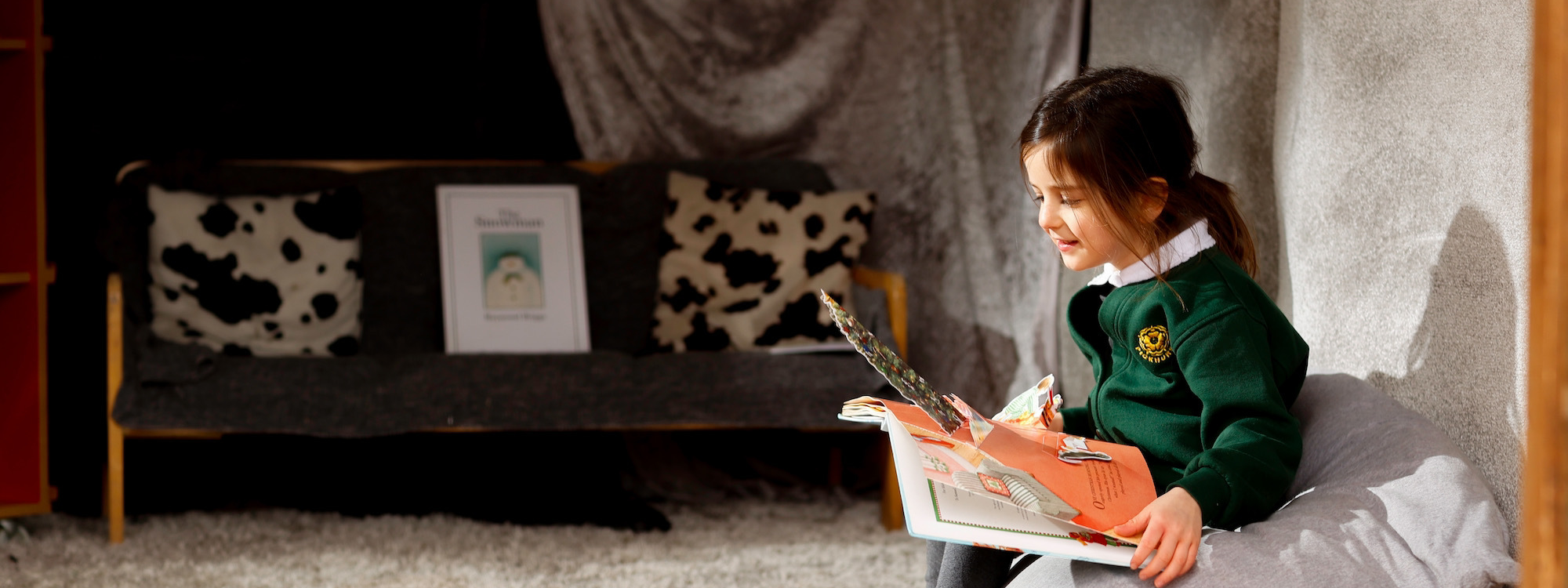- Home
- About Us
- Curriculum Subjects
- English
English
BackEnglish Curriculum Intent
At Pickhurst Infant School, our English curriculum is at the heart of our mission to nurture confident, articulate, and enthusiastic communicators. We believe that developing strong skills in speaking, listening, reading, and writing is essential for children to thrive in their education and beyond. Our aim is to instil a lifelong love of language and literature while equipping every child with the tools to express themselves clearly and creatively.
Our curriculum is designed to:
Foster a Love of Reading: Introduce children to a rich variety of high-quality texts that spark imagination, expand vocabulary, and develop comprehension skills.
Develop Confident Writers: Encourage children to express their ideas fluently and effectively through writing, with a strong focus on sentence construction, grammar, punctuation, and spelling.
Enhance Speaking and Listening Skills: Promote confident verbal communication and attentive listening, enabling children to share ideas, participate in discussions, and build strong interpersonal skills.
Support Early Language Development: Provide a solid foundation in phonics, ensuring children can decode words accurately and develop fluency in reading and writing.
Celebrate Creativity: Inspire children to use their imaginations and personal experiences as they explore different forms of storytelling and self-expression.
Our curriculum is inclusive and ambitious, ensuring that all children, regardless of background or ability, are supported and challenged to achieve their potential. We carefully sequence learning to build on prior knowledge, enabling children to make connections and deepen their understanding over time.
Through our English curriculum, we aim for every child to leave our school as a confident reader, an enthusiastic writer, and an effective communicator, ready to embrace the next stage of their learning journey.
Spoken Language
Language and Vocabulary Development
Starting in Reception, we endeavour to provide our pupils with a 'language rich' environment and a range of opportunities to develop oracy skills. We have high expectations that our students are able to speak confidently in full, grammatically correct sentences. Across our curriculum, the children explore new and challenging vocabulary to ensure that they broaden their understanding of tier 2 and tier 3 words. Teachers carefully plan which new words they will be exploring, ensuring consistency across the year group. These new words are explored in context to ensure that the children have sound understanding of how to use them on a daily basis. Ambitious language is displayed on classroom working walls and in the hall. Frequently, a new word is shared and explained in assembly in order to promote and encourage language curiosity. All the children are active Word Collectors and are encouraged and rewarded for finding new words in and out of school.

To promote effective communication, teachers introduce the children to a range of Kagan collaborative language structures. These are used frequently throughout the curriculum in order to maximise learning time and to embed the need to take turns and to listen to each other effectively.
As a result, we have a community of enthusiastic readers and writers who enjoy showcasing their developing literacy knowledge and skills. They are confident exploring and taking risks in their reading and writing, and love to discuss and share their ideas in an eloquent manner. Our attainment at the end of EYFS and KS1 is consistently above Bromley’s and the national average.
Reading
Reading Intent
Our reading intent is linked to our overarching curriculum intent to ‘develop our children as confident, independent and thoughtful learners who communicate effectively and who show a lifelong love of learning and a thirst for creativity’
At Pickhurst Infant Academy, we believe that reading is the key to unlocking a world of learning and opportunities. Our reading curriculum is designed to ensure that every child develops the skills and confidence to become a fluent, competent, and enthusiastic reader. Reading is at the heart of our curriculum, underpinning all areas of learning and inspiring a lifelong love of books and storytelling.
We aim to create a rich and stimulating environment where children are immersed in high-quality literature from a wide range of genres, cultures, and traditions. Through carefully chosen texts and engaging teaching strategies, we provide children with the tools to decode, comprehend, and interpret written language, equipping them with the ability to read for both purpose and pleasure.
Our approach emphasises the systematic teaching of phonics as the foundation for early reading skills, ensuring every child is supported to achieve fluency. We use the Little Wandle Lettes and Sounds Revised phonics scheme, and children start learning phonics from their very first week at school. Alongside this, we foster a love of reading by sharing captivating stories, poems, and non-fiction that spark imagination, curiosity, and enjoyment. We encourage children to explore books independently and through shared experiences, nurturing their confidence and inspiring them to see themselves as readers.
We recognise that reading unlocks access to all areas of the curriculum, empowering children to acquire knowledge, think critically, and develop a broader understanding of the world. Our reading curriculum also prioritizes fostering a deep connection with texts, encouraging children to empathise with characters, make links, explore different perspectives, as well as developing their vocabulary and language skills.
By placing reading at the heart of our school, we aim to cultivate a community of readers who are confident, competent, and curious learners, ready to embrace the endless possibilities that reading brings to their lives.
Reading Implementation
Reading Sessions
At Pickhurst Infant Academy, reading is an integral part of our curriculum, taking place three times a week in reading groups led by a teacher or teaching assistant. For children who require additional support, one-on-one sessions with a teacher ensure their individual needs are met. During these sessions, children work with fully decodable books, allowing them to develop key skills such as decoding, prosody, and comprehension.
Every class enjoys a daily high-quality story time, where teachers model fluent and expressive reading. This not only promotes enjoyment but also encourages discussions about story content, fostering a deeper appreciation for literature. We closely monitor children’s reading progress at home and actively encourage parents to engage with us, forming a strong partnership to support their child's development.
Phonics and Reading Progression
In Reception and Year 1, children use books from the Little Wandle for Letters and Sounds scheme, carefully matched to their phonics level. As they progress to Year 2, they continue with Little Wandle until they complete Phase 5, after which they transition to Big Cat Collins books. These texts emphasise comprehension and prosody, ensuring children develop the diverse skills required to become confident, well-rounded readers.
Reading for Pleasure
We believe fostering a love of reading is essential for every child. Reading is celebrated and promoted throughout our school, with vibrant displays highlighting children’s literature and celebrating both student and staff reading habits. Each day, teachers read high-quality texts to their classes, giving children opportunities to hear fluent reading and to discuss stories.
Children have access to inspiring and well-stocked class libraries, offering a wide variety of fiction, non-fiction, poetry, magazines, and graphic novels. They are encouraged to choose books they enjoy and to engage in book discussions with peers and teachers. During warmer months, reading often moves outdoors, with stories shared on the grass, in the Forest School reading area, or even with our mentor dogs.
We worked with our wider community to create our ‘Little Oaks Library’ which provides an attractive and welcoming space in which children can become immersed in their reading.
Phonics-and-Early-Reading-Powerpoint.pptxEverybody-read-leaflet-for-parents.pdf
Impact
As a result, we have a community of enthusiastic readers who enjoy showcasing their developing literacy knowledge and skills. They are confident to take risks in their reading and writing, and love to discuss and share their ideas in an eloquent manner. Our attainment at the end of EYFS and KS1 is above that of both Bromley’s and the national average.
reading-policy-2021-22-final.docx
reading-and-phonics-guide-for-parents-and-carers.pdf
Reading-helpers-powerpoint.pdf
recommended-reading-lists-reception.pdf
Phonics
Phonics
We use a systematic approach to teaching of phonics, ensuring every child is supported to achieve fluency. We use the Little Wandle phonics scheme and children start learning phonics from their very first week at school.
In Reception and Year 1, children use books from the Little Wandle for Letters and Sounds scheme, carefully matched to their phonics level. As they progress to Year 2, they continue with Little Wandle until they complete Phase 5, after which they transition to Big Cat Collins books. These texts emphasise comprehension and prosody, ensuring children develop the diverse skills required to become confident, well-rounded readers.
Children who need additional support are targeted for 1:1 and small group intervention.
Writing
Capital-letter-formation-4.pdf
Our curriculum is designed to develop confident writers. Children are taught to express their ideas fluently and effectively through writing, with a strong focus on sentence construction, grammar, punctuation, and spelling.
handwriting-teaching-sequence.pdf
handwriting-workshop-for-parents-and-carers.pdf
ppp-alphabet-pencil-hold-a3-poster.pdf



